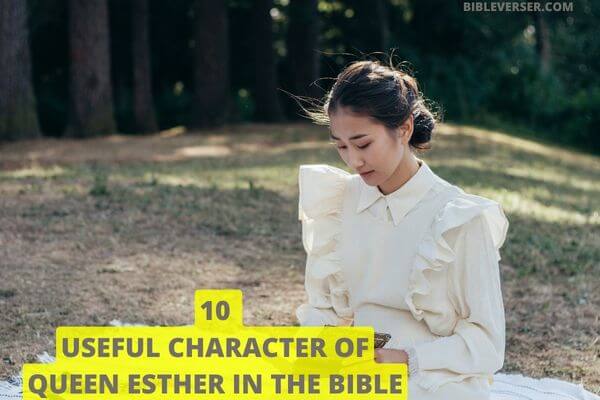The Book of Esther in the Bible tells a story set in ancient Persia. It’s about a Jewish girl named Esther who becomes queen. She hides her Jewish identity at first. But when a powerful man named Haman plans to harm her people, Esther bravely speaks up to the king.
Esther’s courage saves her people, the Jews, from destruction. She reveals her true identity to the king and exposes Haman’s evil plan. The king listens to Esther and punishes Haman instead.
The story shows how God works behind the scenes to protect His people. Even though God’s name isn’t mentioned, it’s clear He’s watching over Esther and the Jews. Esther’s bravery and trust in God teach us about courage and standing up for what’s right.
In the end, the Jews celebrate their deliverance with a festival called Purim. The Book of Esther reminds us that God is always with us, even when things seem tough. It teaches us to trust Him and be brave like Esther.
Character Of Queen Esther In The Bible
Queen Esther, a courageous Jewish woman raised by her cousin Mordecai, becomes Queen of Persia. Concealing her identity, she risks her life to thwart Haman’s plot to exterminate the Jews.
Through bravery, strategy, and faith, Esther’s intervention ensures the salvation of her people, exemplifying resilience and divine providence.
Courageous
Esther’s courage is not only displayed in her willingness to risk her life by approaching King Xerxes without being summoned but also in her acceptance of her role as a leader in a time of crisis.
Despite her initial hesitation and fear, she finds the strength to confront daunting challenges head-on.
Strategic
Esther’s strategic acumen is evident in her careful planning and execution of her approach to the king. She doesn’t rush into action impulsively but instead takes the time to assess the situation, gather information, and devise a well-thought-out plan to achieve her objectives.
Resilient
Esther’s resilience is demonstrated by her ability to withstand pressure and adversity without losing hope or giving in to despair. Despite facing significant risks and uncertainties, she remains steadfast in her resolve to do what is right and trusts in God’s guidance and protection.
Selfless
Esther’s selflessness is exemplified by her willingness to sacrifice her own safety and comfort for the sake of her people. She puts the needs of others above her own desires and demonstrates a deep sense of compassion and empathy for those who are suffering.
Wise
Esther’s wisdom is reflected in her discernment and sound judgment in navigating the complex political and social dynamics of the Persian court. She displays intelligence, insight, and diplomatic skill in her interactions with King Xerxes, Haman, and other influential figures.
Faithful
Esther’s faith in God is a central aspect of her character. Despite the absence of explicit religious language in the text, her actions and decisions are guided by a profound trust in God’s providence and a belief in His power to intervene on behalf of His people.
Compassionate
Esther’s compassion for her people is evident in her deep concern for their welfare and her willingness to take action to alleviate their suffering. She is moved by their plight and motivated by a genuine desire to help and protect them.
Influential
Esther’s rise from obscurity to become queen gives her a platform and a position of influence from which to advocate for her people. She uses her position strategically to leverage her influence and sway the decisions of those in power.
Strategic Communicator
Esther’s ability to communicate effectively is a key asset in her efforts to achieve her objectives. She knows how to convey her message persuasively, choose her words carefully, and adapt her approach to different audiences to achieve the desired outcome.
Determined
Esther’s determination and perseverance are evident in her unwavering commitment to see her mission through to the end.
Despite facing obstacles, opposition, and setbacks along the way, she remains steadfast in her resolve and refuses to give up until her goals are accomplished.
What Is The Main Message Of The Book Of Esther?
The main message of the Book of Esther, found in the Hebrew Bible or Old Testament, is often interpreted as a testament to divine providence, the courage of individuals to stand up against oppression, and the preservation of the Jewish people.
The story revolves around a Jewish woman named Esther who becomes queen of Persia and ultimately saves her people from a plot to exterminate them.
Key themes in the Book of Esther include:
Divine Providence
Although the name of God is not explicitly mentioned in the Book of Esther, many interpret the events as being guided by divine providence.
Esther’s rise to power, her courage in revealing her identity as a Jew, and the eventual deliverance of her people are seen as evidence of divine intervention, even if it is not overtly stated.
Courage and Agency
Esther’s bravery in risking her life to save her people, as well as the actions of her cousin Mordecai, who refuses to bow to the villain Haman, highlight the theme of individual courage and agency in the face of adversity.
Justice and Reversal of Fortune
The story also emphasizes the theme of justice and the reversal of fortune, as Haman’s plot to destroy the Jews ultimately leads to his downfall and the elevation of Mordecai and Esther.
Identity and Loyalty
Esther’s struggle with her own identity as a Jew, initially concealing it from King Xerxes, reflects themes of identity and loyalty. Ultimately, she embraces her identity and risks everything to save her people.
Celebration and Remembrance
The institution of the festival of Purim, which commemorates the events of the Book of Esther, underscores the importance of celebration and remembrance in Jewish tradition.
How Did God Use Esther In The Bible
In the Bible, particularly in the Book of Esther, Esther is the key figure whom God used to achieve the deliverance of the Jewish people from a plot to exterminate them.
Here are several ways in which God used Esther:
Becoming Queen
Esther’s rise to become queen of Persia is considered by many to be part of God’s plan. Her position of influence allowed her to have access to King Xerxes and ultimately play a crucial role in thwarting the plot against her people.
Intervention on Behalf of Her People
Esther’s courageous decision to approach King Xerxes without being summoned, risking her own life in the process, is often interpreted as being guided by God. Her plea to the king to spare her people demonstrates her faith and reliance on divine intervention.
Exposing Haman’s Plot
Esther’s revelation of Haman’s sinister plot to destroy the Jews, as well as her role in exposing his treachery to King Xerxes, is seen as a pivotal moment orchestrated by God to bring about justice and deliverance.
Protection and Preservation of the Jewish People
Through Esther’s actions, God ensured the protection and preservation of the Jewish people from destruction. Esther’s bravery and intervention led to the reversal of the decree to annihilate the Jews, allowing them to defend themselves and emerge victorious.
What Does The Story Of Esther Teach Us?
The story of Esther offers timeless lessons about courage, faith, justice, and the resilience of the human spirit in the face of adversity.
It continues to inspire and resonate with people of various backgrounds and faiths around the world.
Here are some key lessons derived from the narrative:
Courage in the Face of Adversity
Esther’s courage to approach King Xerxes, risking her life to intercede for her people, teaches us the importance of standing up for what is right even in the face of great danger.
Faith and Trust in God
Although the name of God is not explicitly mentioned in the Book of Esther, the story is often seen as a testament to divine providence. Esther’s faith and reliance on God’s guidance, even when His presence seems hidden, remind us of the importance of trusting in a higher power during challenging times.
The Power of Prayer and Fasting
Esther’s call for prayer and fasting before she approached the king highlights the efficacy of seeking spiritual guidance and support in times of need.
The Dangers of Prejudice and Hatred
The story exposes the dangers of prejudice and hatred, as seen in Haman’s plot to exterminate the Jews simply because of their ethnicity. It serves as a reminder of the destructive nature of discrimination and the importance of combating bigotry in all its forms.
Justice and Redemption
The downfall of Haman and the salvation of the Jewish people demonstrate the triumph of justice over injustice and the possibility of redemption even in the darkest of circumstances.
The Role of Women in Leadership
Esther’s leadership and courage as a woman in a male-dominated society challenge traditional gender roles and underscore the importance of women’s contributions to history and society.
The Importance of Remembrance and Celebration
The establishment of the feast of Purim as a time of celebration and remembrance reminds us of the importance of commemorating past victories and expressing gratitude for deliverance.
The Impact of Individual Actions
The story emphasizes the profound impact that individual actions can have on the course of history. Esther’s bravery and intervention ultimately saved the lives of her people, highlighting the significance of individual agency in shaping events.
What Is The Scripture Story Of Esther?
Esther 2:17
“Now the king loved Esther more than all the other women, and she obtained grace and favor in his sight more than all the virgins; so he set the royal crown upon her head and made her queen instead of Vashti.”
Esther 4:14
“For if you remain completely silent at this time, relief and deliverance will arise for the Jews from another place, but you and your father’s house will perish. Yet who knows whether you have come to the kingdom for such a time as this?”
Esther 4:16
“Go, gather all the Jews who are present in Shushan, and fast for me; neither eat nor drink for three days, night or day. My maids and I will fast likewise. And so I will go to the king, which is against the law; and if I perish, I perish!”
Esther 5:1
“Now it happened on the third day that Esther put on her royal robes and stood in the inner court of the king’s palace, across from the king’s house, while the king sat on his royal throne in the royal house, facing the entrance of the house.”
Esther 6:1
“That night the king could not sleep. So one was commanded to bring the book of the records of the chronicles; and they were read before the king.”
Esther 7:3-4
“Then Queen Esther answered and said, ‘If I have found favor in your sight, O king, and if it pleases the king, let my life be given me at my petition, and my people at my request. For we have been sold, my people and I, to be destroyed, to be killed, and to be annihilated.'”
Esther 8:7
“Then King Ahasuerus said to Queen Esther and Mordecai the Jew, ‘Indeed, I have given Esther the house of Haman, and they have hanged him on the gallows because he tried to lay his hand on the Jews.'”
Esther 8:17
“And in every province and city, wherever the king’s command and decree came, the Jews had joy and gladness, a feast and a holiday. Then many of the people of the land became Jews, because fear of the Jews fell upon them.”
Esther 9:22
“as the days on which the Jews had rest from their enemies, as the month which was turned from sorrow to joy for them, and from mourning to a holiday; that they should make them days of feasting and joy, of sending presents to one another and gifts to the poor.”
Esther 9:28
“So these days were remembered and celebrated throughout every generation, every family, every province, and every city; and these days of Purim were not to fail among the Jews, or to perish from the memory of their descendants.”
Esther 2:20
“Esther had not revealed her nationality and family background, because Mordecai had forbidden her to do so.”
Esther 3:5-6
“When Haman saw that Mordecai would not kneel down or pay him honor, he was enraged. Yet having learned who Mordecai’s people were, he scorned the idea of killing only Mordecai. Instead Haman looked for a way to destroy all Mordecai’s people, the Jews, throughout the whole kingdom of Xerxes.”
Esther 4:8
“He also gave him a copy of the text of the edict for their annihilation, which had been published in Susa, to show to Esther and explain it to her, and he told him to instruct her to go into the king’s presence to beg for mercy and plead with him for her people.”
Esther 5:2
“When he saw Queen Esther standing in the court, he was pleased with her and held out to her the gold scepter that was in his hand. So Esther approached and touched the tip of the scepter.”
Esther 7:10
“So they impaled Haman on the pole he had set up for Mordecai. Then the king’s fury subsided.”
Esther 8:3
“Esther again pleaded with the king, falling at his feet and weeping. She begged him to put an end to the evil plan of Haman the Agagite, which he had devised against the Jews.”
Esther 8:8
“Now write another decree in the king’s name in behalf of the Jews as seems best to you, and seal it with the king’s signet ring—for no document written in the king’s name and sealed with his ring can be revoked.”
Esther 9:1
“On the thirteenth day of the twelfth month, the month of Adar, the edict commanded by the king was to be carried out. On this day the enemies of the Jews had hoped to overpower them, but now the tables were turned and the Jews got the upper hand over those who hated them.”
Esther 9:29
“So Queen Esther, daughter of Abihail, along with Mordecai the Jew, wrote with full authority to confirm this second letter concerning Purim.”
What Are The Leadership Qualities Of Esther?
Courage
Esther displays tremendous courage by risking her life to approach King Xerxes without being summoned, which was a dangerous act punishable by death.
Her bravery in confronting the king to plead for the safety of her people exemplifies her leadership in the face of adversity.
Strategic Thinking
Esther exhibits strategic thinking and careful planning in her approach to confronting King Xerxes and revealing Haman’s plot. She recognizes the importance of timing and utilizes her influence and position to achieve her objectives effectively.
Empathy and Compassion
Esther shows empathy and compassion toward her people, identifying with their plight and taking action to protect them from harm. Her concern for the well-being of others exemplifies a key aspect of effective leadership—empathy and caring for those under her charge.
Wisdom and Discernment
Esther demonstrates wisdom and discernment in her interactions with others, particularly in navigating the complex political dynamics of the Persian court. She carefully assesses situations and makes decisions based on insight and understanding.
Adaptability
Esther shows adaptability by adjusting her approach to different situations as they unfold. Whether it’s concealing her identity as a Jew or revealing it at a critical moment, she demonstrates flexibility in response to changing circumstances.
Faith and Resilience
Esther’s faith in God and her resilience in the face of adversity are key aspects of her leadership. Despite the challenges she faces, she remains steadfast in her beliefs and maintains hope for a positive outcome.
Integrity and Morality
Esther upholds principles of integrity and morality throughout the story, refusing to compromise her values even in difficult situations. Her commitment to doing what is right serves as an example of ethical leadership.
Conclusion
Queen Esther, a brave Jewish woman raised by her cousin Mordecai, becomes the queen of Persia. Even though she keeps her Jewish identity hidden, she risks her life to stop Haman’s plan to harm her people.
With courage, clever thinking, and trust in God, Esther saves her people from destruction. Her inspiring story teaches us about bravery, wisdom, and the strength of faith, showing that even in tough times, good can overcome evil.
Esther’s legacy of courage and faith continues to inspire people around the world, reminding us that we can make a difference, no matter how small we may seem.







